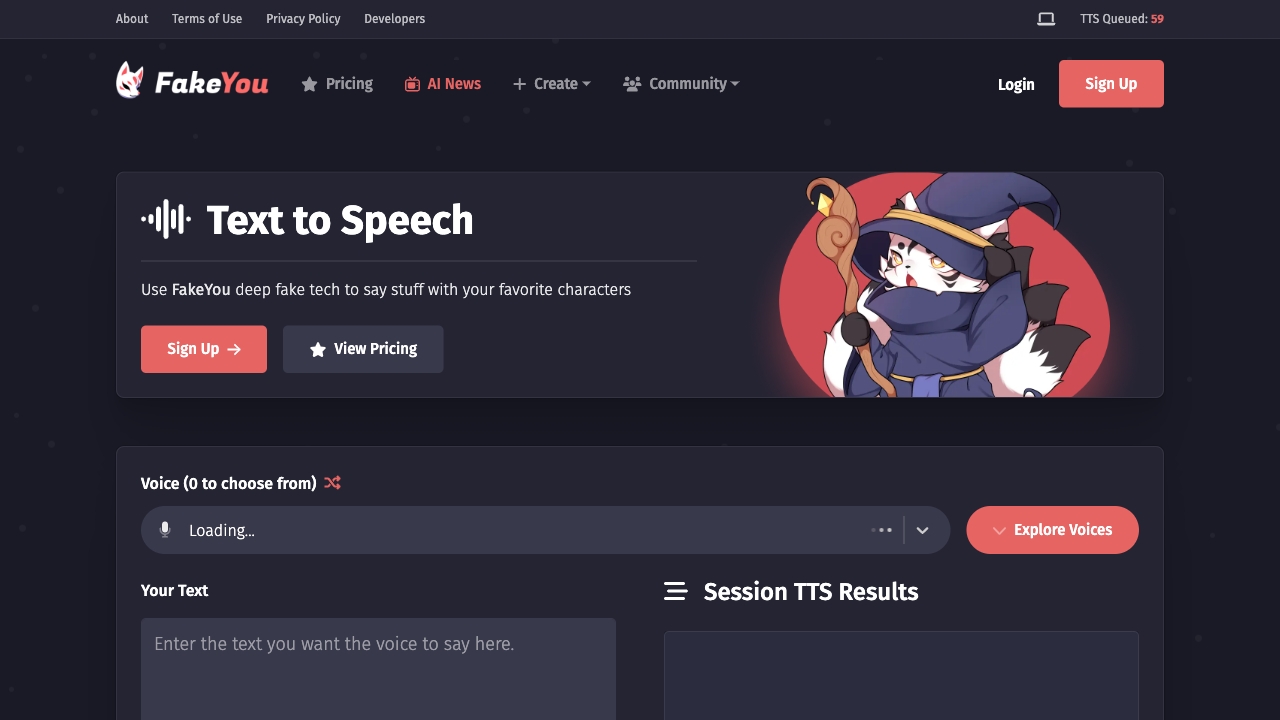- Home
- AI Celebrity Voice Generator
- FakeYou

FakeYou
Open Website-
Tool Introduction:AI transcription with real‑time translation, 5‑hour files, PC editing.
-
Inclusion Date:Oct 21, 2025
-
Social Media & Email:
Tool Information
What is FakeYou AI
FakeYou AI is a voice-generation platform that lets you create character-style audio and lip‑synced videos from any script. It combines high-quality text-to-speech, voice-to-voice conversion, and a voice designer for ethical voice cloning, so you can craft unique performances or replicate your own voice across projects. With a large, searchable catalog of community voices and intuitive controls, FakeYou streamlines narration, dubbing, memes, and prototyping while helping creators stay consistent, experiment quickly, and deliver polished results.
FakeYou AI Main Features
- Text-to-Speech (TTS): Generate natural-sounding speech from text using a wide library of character, celebrity, and stylistic voice models.
- Voice-to-Voice: Transform your recorded performance into a target voice while preserving timing and expression.
- Voice Designer / Cloning: Build a custom, consented voice model to keep branding and tone consistent across projects.
- Lip-Synced Video: Create videos that match spoken audio, useful for character animations, memes, and dubbing.
- Community Voice Catalog: Discover and compare popular models, explore categories, and find voices suited to your script.
- Controls and Export: Adjust pacing and emphasis, preview quickly, then export results in common audio/video formats.
- Responsible Use Tools: Guidance and controls that encourage consent-based cloning and rights-aware publishing.
Who Should Use FakeYou AI
FakeYou AI suits content creators, YouTubers, streamers, and VTubers seeking character voices or quick narration; game developers and modders prototyping NPC dialogue; podcasters and audio drama teams crafting diverse casts; educators and e‑learning authors producing consistent voiceovers; marketers making explainers and promos; and indie filmmakers or animators building animatics and temp dubs.
How to Use FakeYou AI
- Create an account and review the platform’s terms, consent rules, and usage guidelines.
- Choose a workflow: TTS, Voice-to-Voice, or Voice Designer for cloning.
- Select a voice model from the catalog, or prepare clean, consented samples if designing your own voice.
- Enter your script or upload reference audio; tweak settings such as pacing and emphasis to match your style.
- Generate a preview, refine pronunciation with phonetic hints or shorter sentences, and iterate until it sounds right.
- Export audio or lip‑synced video in a suitable format and integrate it into your edit, stream, game, or lesson.
- Publish responsibly, ensuring you have the rights and permissions for the voice and the intended use.
FakeYou AI Industry Use Cases
Studios use FakeYou to produce temp dubs during post and localization, keeping edits moving before final casting. Game teams prototype NPC lines and iterate story beats without booking sessions. Educators scale course narration with a consistent branded voice. Social creators generate character meme reads or short-form dubs. Podcasters build multi-voice scenes, and animation teams pre‑vis lip‑sync for animatics.
FakeYou AI Pros and Cons
Pros:
- Large voice library for diverse characters and styles.
- Flexible modes: TTS, voice-to-voice, and voice cloning.
- Fast previews and straightforward controls for quick iteration.
- Lip‑sync support for video-based workflows.
- Useful for prototyping, temp tracks, and creative experimentation.
Cons:
- Legal and ethical considerations around likeness and rights require careful review.
- Audio quality and realism can vary by model, script, and settings.
- Pronunciation of names, acronyms, or niche terms may need manual guidance.
- Cloning quality depends on clean, high‑quality training samples.
- Lip‑sync results may require additional editing for production-grade polish.
FakeYou AI Popular Questions
-
Is it legal to use character-style voices from FakeYou AI?
Legality depends on the model’s licensing, your jurisdiction, and the use case. Always review the platform’s terms, model-specific permissions, and local laws—especially for commercial projects.
-
Can I clone my own voice?
Yes, you can train a model with your consented recordings. For best results, provide clean, high‑quality samples in a quiet environment and follow the platform’s data guidelines.
-
What formats can I export?
FakeYou typically supports common audio formats (e.g., WAV/MP3) and video for lip‑sync workflows. Check the export panel for the latest supported options.
-
How do I improve pronunciation and clarity?
Break long sentences, add punctuation, use phonetic spellings for tricky words, select a voice aligned with your language/accent, and iterate with short previews.
-
Can I use outputs commercially?
Commercial use depends on the specific voice model’s license and the platform’s terms. Obtain necessary permissions and document consent before distributing paid or branded content.


